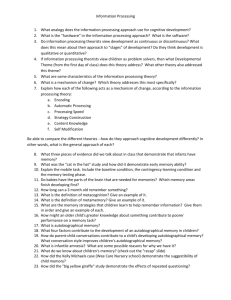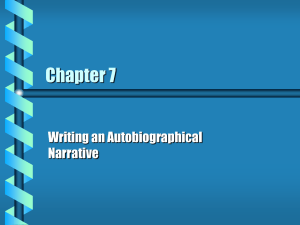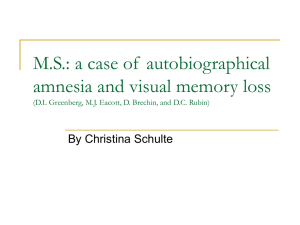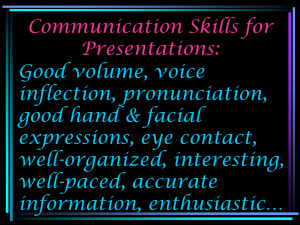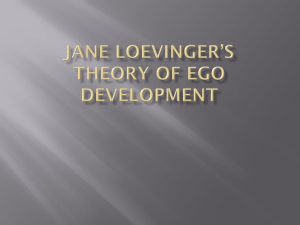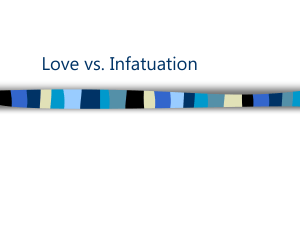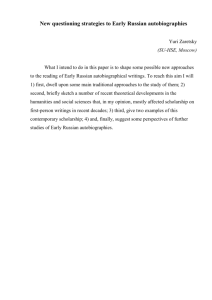PowerPoint
advertisement
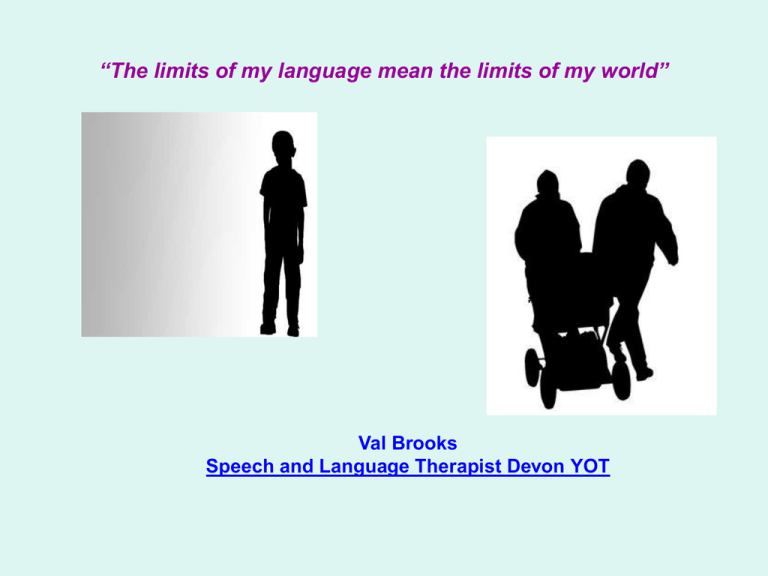
“The limits of my language mean the limits of my world” Val Brooks Speech and Language Therapist Devon YOT “The limits of my language mean the limits of my world” “imagining the real” Martin Buber Attachment-Focused Family Therapy Daniel Hughes Principal components of post-modern systemic family therapy: • The therapist is the participant-manager of the conversation, not the “expert”. • Language, rather than interactional pattern, is the system. • Difficulties are constructed in the language system and can be “dissolved” through language. • Change occurs through development of new language. • Reflecting-teams conversations’ are used to comment and participate in the co-construction of alternative meanings. Systemic family therapy and the influence of post-modernism Paula Boston. Advances in psychiatric treatment 6:450-457 This presentation: • The critical role of early conversation skills in the development of empathy and perspective taking. • Language, narrative and self-reflection: (autobiographical memory and the development of selfidentity). • Language and the identification and resolution of ambivalent emotion. • The role of language development in adolescent social cognition. CONVERSATION AND EMOTIONAL DEVELOPMENT From 18 – 24 months: the majority of talk is about the here-and-now (joint attention). From 24 – 36 months: children's conversational horizons expands; increasingly there is displaced talk about topics that are not immediately present. Autobiographical memory: an explicit memory of an event that occurred in a specific time and place in one’s personal past recalled from the unique perspective of the self in relation to others. • • • • Visual memory Auditory memory Episodic memory “I was there, I did that” Semantic memory Not all personal memory is, or becomes, autobiographical – scripts of routinely experienced events. Autobiographical memory is not just referenced to the self, it is personally significant, concerned with episodes that have personal meaning: emotions, motivations and desires (goals). Autobiographical memory Components: • • • • • Brain development & basic memory systems Conversations with adults (parents/carers and others) Complex expressive language Receptive and expressive narrative skills Temporal understanding • (Further development during adolescence) Language (conversations & narrative language) critical to the development of autobiographical memory. = Perspective taking Understanding of self and others (theory of mind) Maternal Narrative Style (40 months) High-elaborative Low-elaborative M: What was near the ocean that you played with? Child: I don’t know. M: Do you remember that we used to walk, we used to walk on the beach and… Child: Um hmmm, Mummy. M: You don’t remember? Child: You tell me. M: Remember we picked up sea… Child: Uh huh. M: …..shells. Remember all the seashells we collected? M: Who else went with us? Think about who was in the car, when we went…. Child: Tyler (younger brother). M: Did Tyler go with us? Child: Yeah. M: No, Tyler didn’t go with us. Who else went? Did Daddy go? Child: Yeah. M: He did? Now think about who was in the car the day we went. Child: You and Daddy did. Mother: Daddy wasn’t there. What was sitting up front with Mummy? 8 years old M: Do you remember any animals at that zoo that we don’t have at our zoo? Child: Umm, cheetahs. M: Yeah. Oh I remember one. Child: What? M: Kinda’ big. Child: Oh, white white tiger. M: Yeah, that’s right. They had white tigers… You know what? We may not have seen them now that I think about it. The hippos. Were the hippos out? Child: I don’t think so. Oh, the kangaroos. M: Oh Yeah! They had kangaroos, didn’t they? Child: Um hmm. M: I forgot about that. M: Do you remember last summer when we were in Mount Eagle? Child: I think. M: Well, Andrew and Emma and all of them were there. Child: Yea. M: And Lisa… Child: Um hmm. M: …brought out some… Child: Shaving cream. We had a shaving cream fight. I covered myself, but I… M: Tell me about that. How did you do all that? Child: You know, you were there. M: Well, I wasn't down there. I was just watching. Child: So, you were still there. Differences in Autobiographical Memory • Gender differences (adults): length, detail, vivid, emotionally laden; earlier age of first memory. • Gender differences (children): maternal reminiscing more elaborative with girls than boys. • Children deprived of the ability to converse about the past with adults have deficits in their early memories: deaf children without sign = deaf adults with significantly sparser early memories than hearing adults. • Maternal elaborative reminiscing style: children recall more information, affects children’s memory skills more than 2 years later, predicts children’s developing autobiographical memory skills. (Not related to amount of talk). Correlated with secure attachment. Autobiographical memory “Through the creation of a shared past, we attain a shared perspective on how to interpret and evaluate experience, which leads to a shared moral perspective.” UNDERSTANDING EMOTIONAL AMBIVALENCE (Donaldson and Westerman, 1986) Age range 4 – 5 years to 10 – 11 years Level 0: Deny ambivalent feelings exist. Level 1: Need probing: realise they feel differently at different times depending on the situation. Level 2: Begin to realise contradictory feelings can be experienced towards the same situation or person, but don’t understand how this works. Level 3: Understand ambivalence and recognise that two contradictory feelings can coexist at the same time towards the same person. Feelings understood in a wider context and can influence one another. CHILDREN’S THEORIES ABOUT WHAT MAKES FEELINGS CHANGE (Donaldson and Westerman, 1986) Age range 4 – 5 years to 10 – 11 years Level 1: Feelings come and go in response to external events (children passive, no control over emotions) Level 2: Beginning awareness that thoughts and memories affect ebb and flow of feelings. Level 3: Feelings come and go largely in response to memories, thoughts and attitudes. Feelings elicited by inner processes – children can begin to exert control over their emotions and take responsibility for their behaviour. Prefrontal cortex: uniquely large in humans, concerned with the highest brain functions e.g. abstract thinking, decision making, anticipating the effects of a particular course of actions, social behaviour. Executive Functioning The ability to plan effective social communication. E.g. when plans involve other people, planner must consider people’s emotional responses. Social cognitive development and its related perspective taking shows a marked change during preadolescence and adolescence. As young people develop they are able to manipulate and integrate more and more pieces of information simultaneously. These executive functions improve over the course of adolescence: • • • • • • Selective attention Working memory (Language) Problem solving (Language) Processing speed Prospective memory (Language) Inhibitory control of responses and impulses (Language) The Emergence of Autobiographical Memory: A Social Cultural Developmental Theory. Katherine Nelson & Robyn Fivush, Psychological Review, 2004 Vol. 111, No2, 486 – 511 Neuroeducational Research Network (NEnet) Based at Bristol University Aim: researching the implications of neuroscience for education. Also Centre on the Developing Child (Harvard University)
